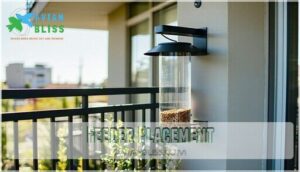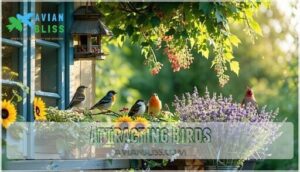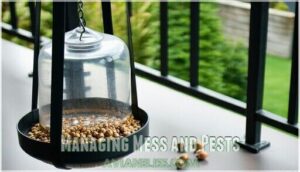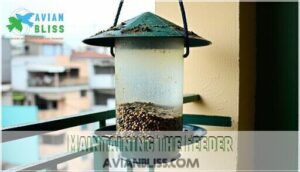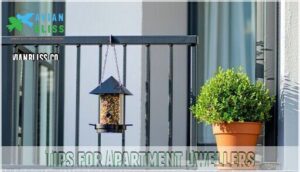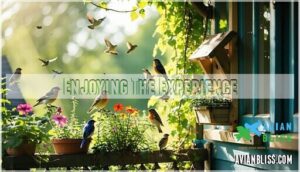This site is supported by our readers. We may earn a commission, at no cost to you, if you purchase through links.
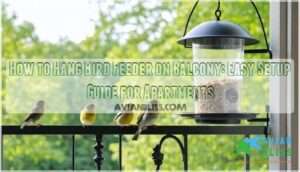 To hang a bird feeder on your balcony, you’ll need a secure mounting system like a clamp-on bracket, suction cup hook, or railing attachment.
To hang a bird feeder on your balcony, you’ll need a secure mounting system like a clamp-on bracket, suction cup hook, or railing attachment.
Position the feeder 3-4 feet from walls so birds can approach safely without feeling trapped. Choose lightweight feeders to prevent stress on your railing, and guarantee proper drainage to avoid mold.
Use no-mess seeds like sunflower hearts to minimize cleanup below. Check your lease agreement first – some buildings restrict balcony feeders.
Mount at eye level for ideal bird watching and easy refilling. The key is creating a stable, accessible feeding station that won’t become a neighborhood nuisance.
Strategic placement and smart seed choices can transform your urban perch into a surprising wildlife magnet.
Table Of Contents
- Key Takeaways
- How to Hang Bird Feeder on Balcony?
- Choosing The Right Feeder
- Balcony Preparation
- Hanging The Feeder
- Attracting Birds
- Managing Mess and Pests
- Maintaining The Feeder
- Tips for Apartment Dwellers
- Enjoying The Experience
- Frequently Asked Questions (FAQs)
- How to put a bird feeder on a balcony?
- What is the 5 7 9 rule for bird feeders?
- How to hang a bird feeder from an apartment window?
- How do you attach a bird feeder to a balcony?
- Will birds use a bird feeder on a balcony?
- How do you hang a bird feeder off a deck?
- How do you hang a bird feeder outside?
- How to hang a balcony bird feeder?
- How do you hang a bird feeder?
- Do you need a bird feeder for an apartment balcony?
- Conclusion
Key Takeaways
- Check your lease first – Review apartment guidelines and building policies, since many complexes restrict balcony modifications or wildlife feeding, with potential fines up to $1,000.
- Use secure mounting hardware – Choose railing clamps, over-the-rail hooks, or heavy-duty suction cups that support your feeder’s weight and will not create safety hazards for people below.
- Position strategically for bird safety – Place feeders 6-8 feet high, 3-4 feet from walls, and near vegetation, while avoiding windows to prevent bird strikes and give birds safe escape routes.
- Maintain regularly with no-mess seeds – Clean feeders every two weeks, use hulled sunflower hearts or suet to minimize spillage, and store seeds properly to prevent attracting pests or creating neighbor complaints.
How to Hang Bird Feeder on Balcony?
Setting up your balcony bird feeder starts with checking apartment guidelines and selecting appropriate feeder materials.
Choose hanging bird feeders with secure hanging tools like railing clamps or hooks that match your balcony layout.
Position feeders considering bird behavior patterns and feeder safety requirements.
Proper bird feeder installation on your balcony railing using quality bird feeder hooks guarantees stability and attracts local species effectively.
Choosing The Right Feeder
Selecting the right feeder determines which bird species you’ll attract and how successfully your balcony transforms into an urban wildlife haven.
Your choice should balance the feeding preferences of local birds with practical considerations like mess control, weather resistance, and your specific balcony constraints, to create a harmonious and successful environment.
Types of Bird Feeders
Choosing the right feeder transforms your balcony into a bird haven.
Different types attract specific species while minimizing mess and maintenance headaches. Understanding various bird feeder options is essential for the best results.
- Tube Feeders – Perfect for finches and chickadees with multiple ports and squirrel-resistant designs
- Platform Feeders – Attract ground-feeding birds like sparrows with open tray surfaces
- Hopper Feeders – House-shaped gravity dispensers ideal for cardinals and larger songbirds
- Suet Feeders – Metal cages for woodpeckers, best in cooler weather
- Nectar Feeders – Red hummingbird attractors using sugar-water solutions
Feeder Placement
Positioning your balcony bird feeder requires strategic thinking about feeder height and balcony layout.
Place feeders 6-8 feet high on railing types that support secure mounting.
Consider wind direction when selecting your hanging location – sheltered spots prevent seed spillage while maintaining seed visibility.
Your feeder installation should balance accessibility for birds with protection from harsh weather, creating an ideal bird feeder placement that attracts diverse species to your balcony bird feeder.
Balcony Preparation
Before installing your bird feeder, you’ll need to review your apartment’s lease agreement or homeowners association guidelines to verify balcony bird feeding is permitted.
A clean, well-prepared balcony creates the ideal foundation for successful bird watching and prevents attracting unwanted pests or creating maintenance issues.
Reviewing Apartment Guidelines
Before mounting your bird feeder, thoroughly check your lease agreement for balcony restrictions.
Many apartment complexes prohibit hanging items from railings due to liability concerns and structural safety requirements.
Key considerations for apartment dwellers:
- Lease Restrictions – Review pet policies and balcony rules that may limit feeder types
- Tenant Rights – Understand weight limits and approved hanging hardware for balcony railing mounting
- Noise Levels – Consider neighbors when selecting bird feeder locations to avoid complaints
Maintaining a Clean Balcony
Daily balcony cleaning prevents pest invasions and maintains bird sanctuary appeal.
Feeder sanitizing weekly with mild soap eliminates harmful bacteria.
Proper seed storage in airtight containers prevents spoilage.
Regular waste management keeps surfaces welcoming for feathered visitors.
| Task | Frequency |
|---|---|
| Feeder cleaning | Weekly |
| Balcony cleaning | Daily |
| Seed storage check | Bi-weekly |
| Pest control inspection | Weekly |
| Waste management | Daily |
Hanging The Feeder
Now you’ll secure your feeder using two primary methods that work reliably on most apartment balconies. Each mounting option offers distinct advantages depending on your railing design and weight requirements.
Attaching to Railings
Railing clamps offer the most secure attachment method for your balcony bird feeder. These adjustable feeder brackets fit railings from 1-4 inches wide and support up to 20 pounds.
Clamp mounts require no drilling, making them renter-friendly. Position your bird feeder mounting hardware away from air conditioning units.
Hanging hooks with powder-coated steel resist weather damage better than plastic alternatives. When selecting a railing clamp, consider the railing clamp types to guarantee a sturdy hold for your bird feeder.
Using Hanging Baskets
Hanging baskets transform your balcony railing into a bird-friendly oasis.
Choose sturdy basket materials like metal or reinforced plastic that support your bird feeder mounting weight limits—typically 4-7 pounds.
Secure hanging planters using over-the-railing hooks or clamp-style mounting options.
Select appropriate basket sizes that won’t overwhelm smaller balconies while providing stable hanging techniques for your balcony bird feeder setup.
Attracting Birds
You’ll discover that creating the perfect habitat extends beyond just hanging a feeder – it’s about transforming your balcony into a natural sanctuary birds can’t resist.
Research shows that feeders placed near vegetation attract 35% more birds, so combining strategic placement with bird-friendly plants creates an irresistible outdoor dining experience.
Creating a Bird-Friendly Habitat
Once your balcony bird feeder installation steps are complete, focus on habitat design to boost bird diversity.
Transform your space into an urban wildlife haven by adding water sources, native plants, and shelter options that support nature conservation.
- Water features like fountains create mesmerizing sounds that attract birds while providing essential hydration
- Potted native plants offer natural perches and cover that make birds feel secure and welcome
- Strategic placement near vegetation increases visitation by 35% in urban settings, creating thriving bird friendly balconies
This eco friendly approach to balcony decor ideas combines functionality with beauty, using proper bird feeder hanging hardware to create sustainable urban habitats.
Plant Selection
Why settle for ordinary greenery when you can create an avian paradise? Native plants like coneflowers and black-eyed Susans naturally attract local birds while requiring minimal maintenance.
These bird attractors thrive in containers, making them perfect urban greenery for your bird friendly balconies. By choosing plants that support native food webs, you can create a thriving ecosystem that benefits both birds and the environment.
| Plant Type | Bird Species Attracted |
|---|---|
| Sunflowers | Cardinals, finches |
| Marigolds | Goldfinches, sparrows |
| Berry shrubs | Robins, thrushes |
| Lavender | Hummingbirds, bees |
| Native grasses | Seed-eating songbirds |
Your balcony bird feeder becomes more effective when surrounded by birdfriendly plants that provide natural food sources and shelter.
Managing Mess and Pests
One of the biggest challenges you’ll face is keeping your balcony clean while preventing unwanted visitors like squirrels and pigeons from turning your bird feeder into their personal buffet.
Smart feeder choices and strategic food selection can reduce mess by up to 60% while deterring pests that might otherwise overwhelm your peaceful bird-watching setup, making it a more enjoyable experience with strategic planning.
No-Waste Bird Foods
Smart bird nutrition starts with no-waste bird foods that eliminate cleanup headaches.
Choose no-waste seeds and skip the cleanup drama entirely.
These eco-friendly options keep your balcony spotless while supporting local wildlife.
Using hulled sunflower products can be beneficial for the birds.
- Hulled sunflower hearts – Pre-shelled seeds provide complete nutrition without messy hulls
- Suet cakes and nuggets – Birds consume everything, leaving zero waste behind
- Dried mealworms – Protein-rich treats attract insect-eating species with no debris
Avoiding Seed Spillage
Preventing spillage starts with smart feeder designs that minimize waste.
Choose seed catchers or spill trays underneath your balcony bird feeder to collect dropped seeds.
Select hulled sunflower seeds and no-waste bird foods that birds consume completely.
Position tray feeders strategically for mess reduction.
Clean your balcony weekly – waste minimization prevents pest attraction while maintaining feeder cleaning frequency standards for healthy bird visits.
Maintaining The Feeder
You’ll need to maintain your feeder regularly to keep birds healthy and prevent safety hazards on your balcony.
Clean feeders every two weeks with soapy water and replace seeds every 3-5 days to prevent mold growth and disease transmission, which helps maintain a safe environment and supports the overall health of the birds by preventing disease transmission.
Keeping It Clean
Beyond weekly routines, feeder cleaning every two weeks prevents disease transmission among birds.
Use a 10% bleach solution for thorough sanitization, scrubbing away residue with bottle brushes. Rinse completely and air-dry before bird feeder refilling schedule resumes.
Store seeds in airtight containers to maintain freshness. Regular balcony hygiene through waste management keeps your balcony bird feeder safe and functional.
Avoiding Hazards
Through proper installation, you’ll prevent most bird feeder hazards on your balcony.
Secure feeders with quality clamps to avoid falling hazards that could injure pedestrians below.
Position feeders three feet from windows to reduce bird strikes and window collisions.
Install squirrel deterrents like baffles for effective pest control.
Check mounting hardware monthly for wear.
Choose enclosed designs to minimize feeder swinging during storms, ensuring reliable feeder security and thorough pest prevention.
By following a proper bird feeder setup, you can create a safe and welcoming environment for birds to visit your balcony.
Tips for Apartment Dwellers
Living in an apartment doesn’t mean you can’t enjoy backyard birding—you just need to check your lease agreement and building policies first since some complexes restrict balcony modifications or wildlife feeding.
Being considerate of your neighbors means choosing quieter feeder designs and maintaining clean feeding areas to prevent attracting pests that could impact shared living spaces, which is crucial for harmonious living.
Checking Building Rules
Before installing your feeder, check your apartment guidelines and lease restrictions carefully.
About 68% of rental agreements limit balcony decorations, and many buildings classify feeders as fixtures requiring written approval. Review building codes, noise policies, and insurance requirements with property management.
Some municipalities ban wildlife feeding due to pest concerns, with fines reaching $1,000. When creating a bird-friendly environment, consider bird house basics to guarantee a safe and welcoming space for birds.
Being Mindful of Neighbors
Your balcony bird feeder placement affects everyone around you.
Position feeders away from neighboring windows and patios to minimize noise and mess spillover.
Clean up dropped seeds regularly to prevent attracting pests to shared spaces.
Consider your neighbors’ schedules – early morning bird activity might disturb light sleepers.
Communicate your bird feeding plans with adjacent residents to maintain positive neighbor relations and community awareness in your apartment building.
Enjoying The Experience
Once you’ve successfully established your balcony bird feeding station, you’ll discover that observing avian behavior becomes a rewarding educational experience that connects you with local wildlife patterns.
Documenting your feeder visitors can help you contribute valuable data to citizen science projects while building connections with fellow bird enthusiasts in your community, fostering a sense of local wildlife awareness.
Learning From Your Birds
Bird-watching transforms your balcony into a living laboratory where you’ll discover fascinating avian migration patterns and bird behavior.
Each species displays unique feather care routines and nesting habits that reveal nature’s intricate design.
Track different bird species visiting your balcony bird feeder:
- Morning Cardinals – Watch their bright red plumage catch early sunlight as they crack seeds with powerful beaks
- Chattering Finches – Notice their bird socialization patterns as they feed in small flocks, teaching cooperation
- Graceful Hummingbirds – Marvel at their hovering flight mechanics and rapid wing beats during feeding
- Seasonal Migrants – Document which species appear during different seasons, creating your personal avian calendar
- Feeding Hierarchies – Observe how larger birds defer to smaller, more aggressive species during peak feeding times
Your bird feeder installation becomes a window into complex ecosystems, turning routine balcony preparation into meaningful wildlife observation.
Observing their interactions can even reveal how flock dynamics guarantee safety.
Engaging With The Community
Share your balcony bird feeding adventures with neighbors and fellow enthusiasts.
Join local birdwatching groups or create informal meetups to exchange tips about bird feeder placement and species identification.
Document your observations and contribute to community education initiatives, which are essential for promoting neighborly birding practices and enhancing everyone’s bird watching journey.
These shared experiences build connections while promoting a sense of community, and local partnerships enhance everyone’s bird watching journey through collective knowledge and mutual support, fostering a deeper understanding of species identification.
Frequently Asked Questions (FAQs)
How to put a bird feeder on a balcony?
Like anchoring a ship in calm waters, you’ll secure your feeder using railing clamps, over-the-railing hooks, or suction cups.
Choose weatherproof attachments that fit your balcony’s structure and support the feeder’s weight safely.
What is the 5 7 9 rule for bird feeders?
This squirrel-proofing technique positions feeders 5 feet from horizontal structures, 7 feet above ground, and 9 feet below overhanging objects.
You’re creating jump-proof zones that exploit squirrels’ physical limitations while giving birds safe access.
This approach aligns with the 5-7-9 rule for keeping squirrels away.
How to hang a bird feeder from an apartment window?
Don’t put all your eggs in one basket—use multiple mounting options for security.
Attach suction cup feeders to clean, dry glass surfaces or clamp-on brackets to window frames, ensuring they’re weatherproof and positioned away from air conditioning units.
How do you attach a bird feeder to a balcony?
You’ll need secure mounting hardware to attach your feeder safely.
Use railing clamps for horizontal rails, wall brackets with masonry anchors for concrete walls, or heavy-duty suction cups for glass surfaces—each supporting your feeder’s weight.
Will birds use a bird feeder on a balcony?
Absolutely, you’ll attract various bird species to your balcony feeder!
Urban birds like finches, chickadees, and sparrows readily visit elevated feeding stations.
Position feeders 6-8 feet high for ideal songbird activity and safety.
How do you hang a bird feeder off a deck?
Like a lifeline extending into nature’s domain, you’ll secure your deck feeder using clamp-on brackets, over-the-railing hooks, or adjustable pole systems with weighted bases for stability and easy access.
How do you hang a bird feeder outside?
Choose secure mounting options like clamp-on brackets for railings, over-the-railing hooks, suction cups for windows, or wall brackets. Position feeders 3+ feet from glass to prevent bird strikes.
How to hang a balcony bird feeder?
Use railing clamps, over-the-rail hooks, or suction cups for secure attachment. Position 6-8 feet high, near plants for cover. Verify that the weight capacity matches your feeder’s specifications for safety.
How do you hang a bird feeder?
Select secure mounting hardware that fits your balcony’s structure. Clamp-on brackets work for railings up to 2 inches thick, while suction cups hold 4 pounds on clean glass surfaces effectively.
Do you need a bird feeder for an apartment balcony?
You don’t need special bird feeders for apartment balconies, but they’re highly recommended.
Standard feeders work perfectly when properly secured to railings or walls using clamps, brackets, or suction cups for safety.
Conclusion
Successfully mounting a bird feeder requires proper equipment, strategic positioning, and ongoing maintenance.
Choose appropriate mounting hardware for your railing type, position feeders 3-4 feet from walls, and select lightweight models with drainage features.
Regular cleaning prevents disease transmission while no-mess seeds reduce spillage.
When you learn how to hang bird feeder on balcony correctly, you’ll create a sustainable wildlife viewing station that respects building regulations and neighbor considerations, transforming your urban space into an active bird sanctuary.
- https://balconyguide.com/best-bird-feeder-for-apartment-balcony/
- https://www.thayerbirding.com/tips-for-hanging-a-bird-feeder/
- https://www.britannica.com/animal/pigeon
- https://www.bestnest.com/bestnest/lc/lc_window_bird_feeder_faq.asp
- https://www.housedigest.com/1615040/keep-squirrel-off-bird-feeder-5-7-9-rule/


